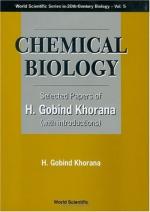|
This section contains 307 words (approx. 2 pages at 300 words per page) |
World of Scientific Discovery on Har Gobind Khorana
Har Gobind Khorana is best known for developing chemical methods to determine the nucleotide sequence of ribonucleic acid ( RNA) and for deciphering the genetic code. For this he shared the 1968 Nobel Prize for physiology or medicine with Marshall Nirenberg and Robert Holley.
Khorana was born in the small village of Raipur, India, where his father was a clerk in the British colonial service. Encouraged by his parents to obtain an education, he received a master's degree in 1945 from the University of Punjab, Lahore (now part of Pakistan). He then went to the United Kingdom, where he earned a doctorate in 1948 from the University of Liverpool. After brief visits to Switzerland and India, he returned to the United Kingdom to do research at Cambridge University during 1950-52, becoming interested in the nucleic acid investigations there. After further study in Switzerland, Khorana took a research position with the British Columbia (Canada) Research Council in Vancouver. In 1960 he joined the faculty of the University of Wisconsin.
Khorana's genetic code work involved using chemical methods and the enzymes deoxyribonucleic acid ( DNA) polymerase and RNA polymerase, which he called "beautifully precise copying machines," to produce long strands of nucleic acids with known base sequences. This allowed him to compare the information-bearing DNA with the corresponding transfer RNA (tRNA) that retrieved specific amino acids for assembly into proteins. Building on Nirenberg's work, Khorana precisely spelled out all sixty-four genetic code triplets (three-base information units) and related them to specific amino acids or terminating functions.
Two years after receiving the Nobel Prize for this work, he made pioneering progress in the construction of yeast and bacteria genes in the laboratory. Khorana also advanced knowledge of the way a cell's protein synthesizing bodies recognize a triplet and correctly assemble the amino acids, as well as how RNA and amino acids recognize each other.
|
This section contains 307 words (approx. 2 pages at 300 words per page) |


